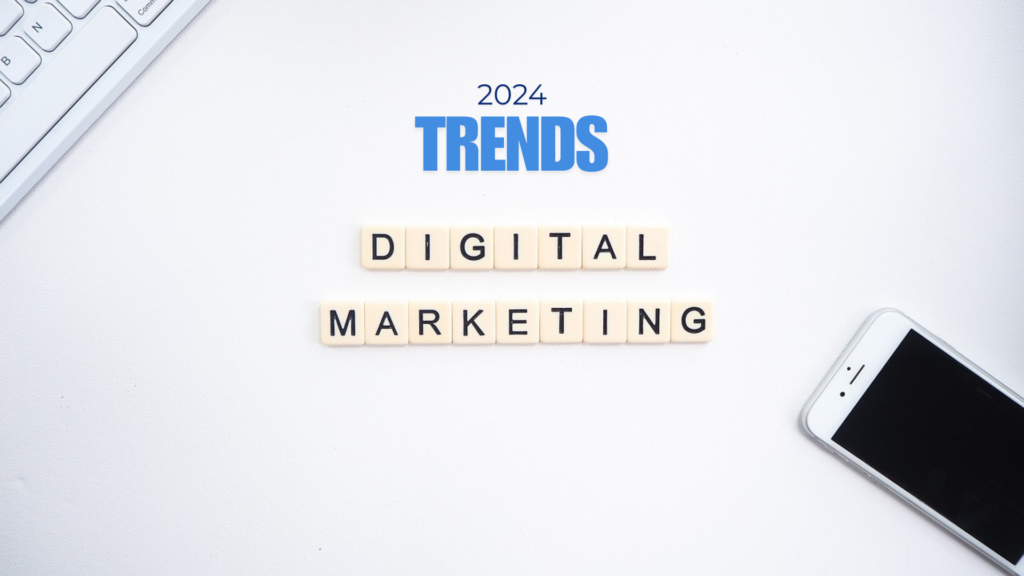2024 Digital Marketing Trends
Digital marketing evolves rapidly, with new technologies and trends reshaping how businesses connect with customers every year. As we move further into 2024, it’s crucial to understand the latest digital marketing trends to stay competitive and deliver exceptional customer experiences. Here’s an in-depth look at the trends expected to dominate digital marketing in 2024, from AI-driven personalization to sustainability-focused marketing strategies.

1. AI-Driven Personalization and Automation
Artificial Intelligence (AI) continues to transform digital marketing by enabling more personalized, efficient customer interactions. In 2024, marketers are using AI to analyze data, predict customer behavior, and automate repetitive tasks, from chatbots to email campaigns.
Key AI Applications in 2024:
- Chatbots: AI-powered chatbots provide real-time customer support and personalized recommendations.
- Predictive Analytics: Marketers use AI to predict customer needs and offer tailored solutions.
- Email Automation: AI-driven tools send personalized emails based on customer behavior and preferences, boosting engagement rates.
Personalization will become even more critical, with AI making it easier for brands to connect with customers in meaningful, customized ways.
2. Voice Search Optimization
With the rising popularity of voice-activated devices like Amazon Alexa, Google Assistant, and Siri, optimizing content for voice search is more important than ever. Voice search is conversational, which means businesses need to adjust their content strategy to answer common, natural-language questions that people ask.
How to Optimize for Voice Search:
- Use long-tail keywords that resemble spoken language.
- Focus on FAQ pages that directly answer customer queries.
- Optimize for local search to capture nearby customers who often use voice search to find local businesses.
Brands that adopt voice search optimization early will have a competitive edge, especially in local and mobile search.
3. Video Marketing and Interactive Content
Video content continues to dominate the digital marketing landscape, with platforms like YouTube, TikTok, and Instagram Reels leading the way. Interactive video content, such as shoppable videos and live streaming, will become a powerful tool for increasing engagement and driving conversions.
Interactive Video Trends:
- Shoppable Videos: Allow customers to click directly on products within a video to make purchases, blending content with commerce.
- Live Streaming: Enables real-time interaction with customers, which is especially popular in retail and service industries.
- User-Generated Content (UGC): Encourages customers to create and share content, creating an authentic connection with the brand.
With the continued rise of short-form and interactive videos, incorporating engaging video content into digital marketing strategies will be crucial in 2024.
4. Influencer Marketing Evolution
Influencer marketing is evolving beyond celebrity endorsements and expanding into partnerships with micro- and nano-influencers who have smaller but highly engaged audiences. These influencers offer a more authentic connection with their followers, making them ideal partners for brands targeting niche markets.
Influencer Marketing Trends for 2024:
- Long-Term Partnerships: Brands are opting for ongoing relationships with influencers to build consistent brand messaging.
- Performance-Based Agreements: Influencers are paid based on the results they deliver, such as engagement or conversions.
- Virtual Influencers: AI-powered “virtual influencers” are making appearances on social media, adding a futuristic twist to influencer marketing.
As consumers become more skeptical of traditional advertising, influencer marketing provides a trusted, relatable way for brands to reach their target audience.

5. Privacy-Focused Marketing and First-Party Data Collection
With increasing privacy regulations, such as the GDPR in Europe and CCPA in California, and the gradual phasing out of third-party cookies, businesses must focus on first-party data to understand and engage their customers. First-party data comes directly from your audience, including data from website interactions, email subscriptions, and customer surveys.
Privacy-Focused Strategies:
- Transparency: Being clear about how customer data is collected and used.
- Value Exchange: Offering incentives, like discounts or exclusive content, in exchange for data.
- Zero-Party Data: Collecting data that customers willingly share, such as through quizzes or preferences settings.
Prioritizing first-party data and respecting privacy will help brands build trust and maintain compliance in 2024’s increasingly privacy-conscious digital landscape.
6. Rise of Sustainability and Ethical Marketing
Consumers are becoming more aware of environmental and social issues, and they expect brands to reflect their values. Sustainability and ethical marketing will be critical for businesses looking to build meaningful connections with customers who prioritize eco-friendly and socially responsible practices.
How to Implement Sustainable Marketing:
- Transparency in Sourcing: Show customers where products come from and how they’re made.
- Eco-Friendly Packaging: Use recyclable or biodegradable packaging to minimize environmental impact.
- Social Responsibility Initiatives: Support social causes and communicate these efforts through marketing campaigns.
In 2024, businesses that incorporate sustainability into their marketing strategies will appeal to conscious consumers who value companies making a positive impact.
7. Enhanced Focus on Customer Experience (CX)
A great customer experience (CX) is essential for retention and brand loyalty. As digital marketing becomes more personalized, businesses are focusing on creating seamless, user-friendly experiences across all touchpoints.
Key CX Enhancements for 2024:
- Omnichannel Marketing: Create a cohesive experience across all platforms—social media, email, website, and in-store.
- Self-Service Options: Offer self-service features such as AI-driven FAQs, knowledge bases, and automated support.
- Customer Feedback: Actively collect and respond to customer feedback to continuously improve the experience.
By focusing on CX, brands can foster loyalty and encourage repeat purchases, a valuable strategy in a competitive market.
8. Short-Form Content Dominance
With the rise of platforms like TikTok and Instagram Reels, short-form content is becoming a preferred medium for capturing attention quickly. In 2024, short-form videos, GIFs, and memes are expected to continue growing in popularity, as they offer an easily digestible format ideal for mobile devices.
Creating Effective Short-Form Content:
- Focus on Storytelling: Share bite-sized stories that engage viewers within seconds.
- Leverage Trends: Tap into trending audio, challenges, and hashtags for broader reach.
- Optimize for Mobile: Ensure content is mobile-friendly, as most short-form content is consumed on smartphones.
With attention spans getting shorter, brands that can create captivating, concise content will be able to engage audiences more effectively.

9. Integration of Augmented Reality (AR) and Virtual Reality (VR)
Augmented Reality (AR) and Virtual Reality (VR) offer immersive experiences that capture customer attention and encourage engagement. Retail, real estate and gaming industries are leading the way in integrating these technologies, and in 2024, we can expect more brands to explore AR and VR for product demos, virtual stores, and interactive experiences.
Popular AR/VR Applications:
- Virtual Try-Ons: Allow customers to visualize products like clothes or furniture in their own space.
- Interactive Ads: Provide an immersive advertising experience that keeps users engaged.
- Gamified Experiences: Use VR to create games or activities that reinforce brand awareness.
AR and VR provide innovative ways to connect with customers, especially among tech-savvy audiences looking for unique and interactive experiences.
10. Rise of the “Super App”
Super applications are versatile applications that coordinate different administrations into one stage, such as WeChat in China. While super applications are not as normal in that frame of mind, there is a developing interest in uniting different computerized administrations under one application to work on client encounters. Significant tech organizations are investigating super application usefulness, especially for web-based entertainment, online business, and monetary administrations.
Potential Super App Features:
- E-Commerce: Integrate shopping, payments, and delivery tracking.
- Social Media: Enable messaging, content sharing, and live streaming.
- Financial Services: Include banking, investment, and payment processing.
Super apps can enhance brand loyalty and user engagement by providing an all-in-one experience, reducing the need for multiple apps.
Conclusion: Embrace 2024’s Digital Marketing Trends
In 2024, digital marketing will be more data-driven, personalized, and focused on providing an engaging customer experience. From leveraging AI and automation to embracing sustainability and privacy, businesses must adapt to these evolving trends to stay relevant and competitive. By integrating these trends into your digital marketing strategy, you can build stronger connections with your audience and drive meaningful results in a constantly changing digital landscape.